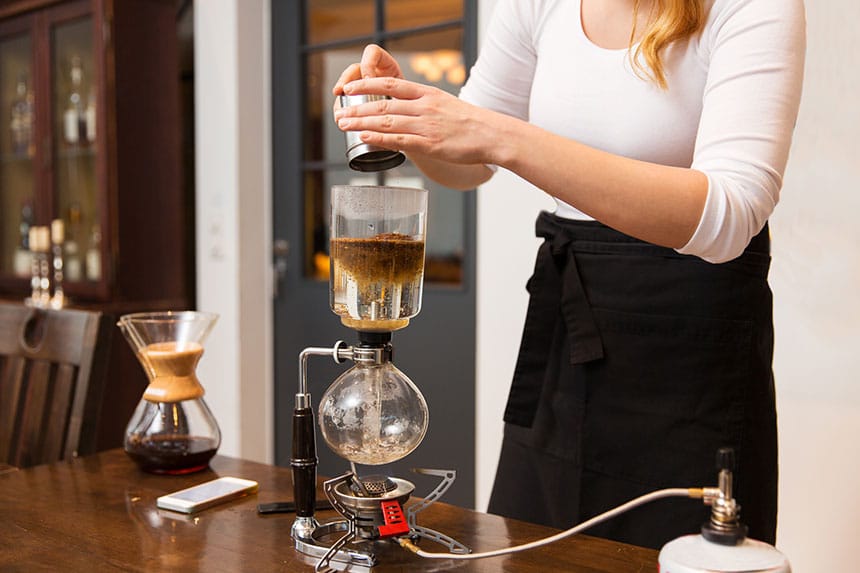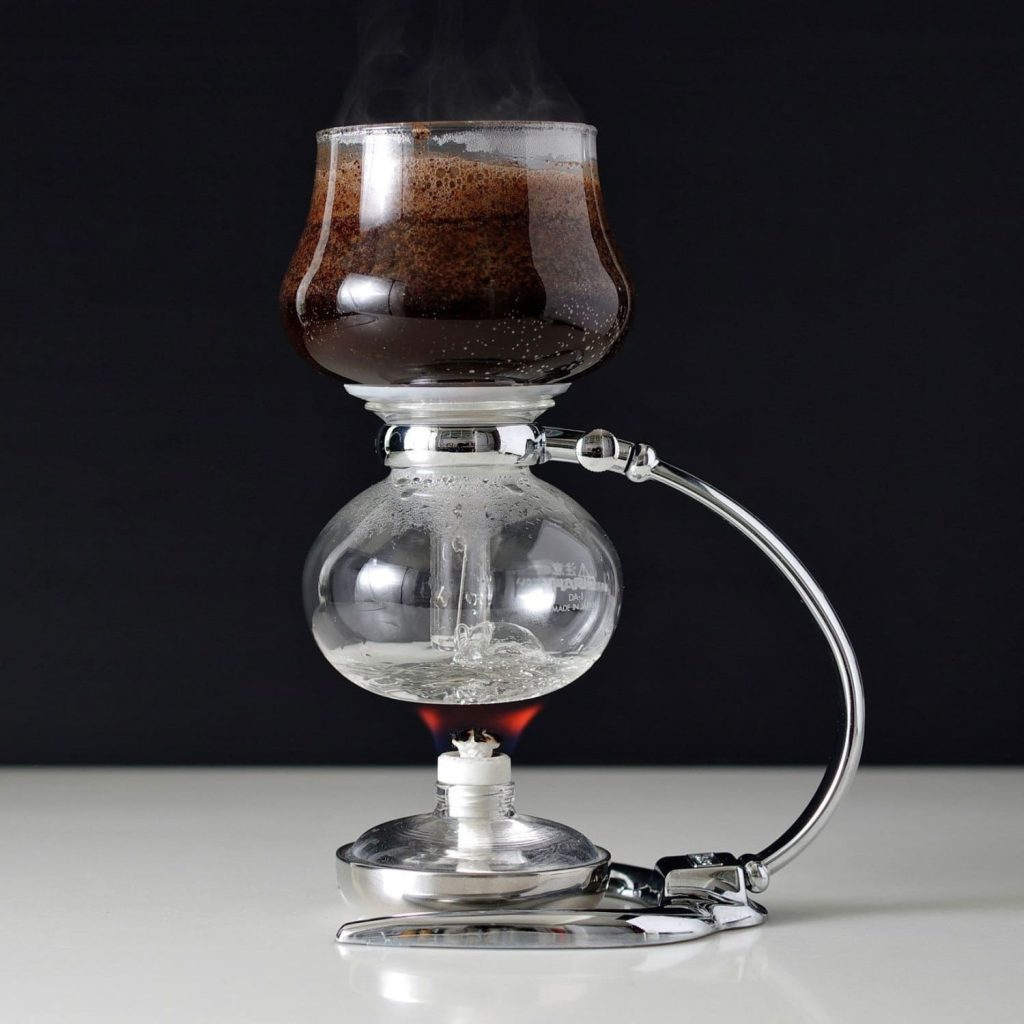Siphon brewing, or vacuum brewing, is a unique and visually impressive coffee-making method. This brewing technique, which dates back to the 19th century, uses two chambers where vapor pressure and vacuum produce coffee.
Unlike other brewing methods, siphon brewing is known for its ability to produce a clean, crisp, and complex cup of coffee. In this article we will now provide you with a good introduction to siphon brewing.

History of Siphon Brewing
The siphon coffee maker, also known as a vacuum pot, was invented in the 1830s by a French housewife and a Scottish engineer. In the early days, it was popular in France and later spread to other parts of Europe and the United States.
Despite the advent of more convenient brewing methods in the 20th century, siphon brewing has endured, particularly among coffee connoisseurs and enthusiasts who appreciate the ritual and the exceptional coffee it produces. Today, siphon brewing is experiencing a resurgence in popularity, with many specialty coffee shops offering it as a premium brewing option.
The Aesthetics of Siphon Brewing
One of the most captivating aspects of siphon brewing is its aesthetics. The siphon brewer, with its twin chambers and open flame, looks more like a piece of laboratory equipment than a coffee maker. It contributes to the sense of theater and ritual that accompanies siphon brewing.
- The process begins with water in a lower chamber and coffee grounds in an upper chamber.
- As the water heats, it rises into an upper chamber to mix with coffee grounds.
- When the heat source is taken away, the brewed coffee descends back into the lower chamber, ready to be served.
This dramatic process is fascinating to watch allowing for a high level of control over the brewing process, making it a favorite among coffee lovers.
The Science Behind Siphon Brewing
The science behind siphon brewing is as intriguing as its aesthetics. The method employs a combination of vapor pressure and vacuum to brew coffee.
- When the water in the lower chamber is heated, it creates vapor pressure.
- This pressure pushes the water into the upper chamber, mixing it with the coffee grounds.
- After the heat source is removed, the drop in temperature creates a vacuum in the lower chamber.
- This vacuum pulls the brewed coffee through the filter and backs down into the lower chamber.
This process results in a clean, crisp, and complex coffee. The quick brewing and filtering process ensures the coffee is not over-extracted or bitter. Instead, siphon brewing highlights the unique characteristics of the coffee, making it an excellent method for enjoying high-quality, single-origin beans.
Understanding the Equipment
The siphon coffee maker or vacuum pot is a unique piece of equipment. It consists of two main parts: the bottom chamber, where the water initially sits, and the brewed coffee ends up, and the top chamber, where the coffee grounds go.
- The bottom chamber is usually bulbous in shape, while the top chamber is more cylindrical and has a siphon tube running through its center.
- A filter, usually made of cloth, metal, or glass, is attached to the siphon tube in the upper chamber.
- The two chambers are sealed together with a rubber gasket to create airtight conditions necessary for the brewing process.
The heat source can be a Bunsen burner, an alcohol burner, or an electric heater. The choice of heat source can affect the temperature control during brewing, which can influence the taste of the coffee.

A Step-by-Step Guide to Siphon Brewing
Siphon brewing may seem complex initially, but with some practice, it becomes a fascinating and rewarding way to make coffee. Here is a step-by-step guide to brewing coffee with a siphon:
- Fill the bottom chamber with water. The amount of water should correspond to the amount you plan to brew.
- Place the filter in the upper chamber attaching the upper chamber to the lower chamber.
- Add the grounds to the upper chamber. A medium to fine grind is typically recommended for siphon brewing.
- Position the siphon brewer over the heat source and turn on the heat. As the water heats, it will rise into the upper chamber.
- Once the water has risen into the upper chamber, you should stir the coffee grounds to ensure they are fully saturated.
- After the coffee has been brewed in the upper chamber for a suitable amount of time (usually around 2 minutes), remove the heat source.
- As the lower chamber cools, it will create a vacuum that pulls the brewed coffee through the filter back to the lower chamber.
- Once all the coffee has been drawn into the lower chamber, remove the upper chamber, and your coffee is ready to serve.
The Role of Vacuum and Vapor Pressure in Siphon Brewing
The siphon brewing process is a fascinating interplay of vapor pressure and vacuum.
- When the water in the lower chamber is heated, creating vapor pressure. This pressure pushes the water up the siphon tube and into the upper chamber, where it mixes with the coffee grounds.
- Once the heat source is removed, the steam in the lower chamber begins to cool and condense, creating a vacuum. This vacuum pulls the brewed coffee down through the siphon tube and back into the lower chamber.
- The rapid change from vapor pressure to vacuum not only moves the water and coffee between the two chambers but also contributes to the unique taste of siphon brewed coffee.
- The quick brewing time and the constant temperature during the brewing process prevent over-extraction, which can lead to bitter coffee. Instead, the coffee brewed in a siphon coffee maker is typically clean, crisp, and complex, highlighting the unique characteristics of the coffee beans.
- Siphon brewing is a unique and fascinating coffee-making method. It combines science and aesthetics to create a coffee brewing experience that is as captivating to watch as delicious to drink.#
The Taste Profile of Siphon Brewed Coffee
Siphon brewed coffee is known for its clean, crisp, and complex flavor. The coffee tends to be lighter and more aromatic than other methods. The flavors are well-defined, allowing the unique characteristics of the coffee beans to shine through. The coffee also tends to have a lighter body and a smoother texture, making it a delight to drink.
Comparing Siphon Brewing to Other Brewing Methods
When compared to other brewing methods, siphon brewing stands out in several ways:
- Pour-over methods like the Chemex or V60 highlight the acidity and brightness of the coffee, but they can sometimes result in a cup that’s too light or thin. Siphon brewing, on the other hand, results in a more balanced and full-bodied cup.
- French press brewing produces a rich, full-bodied coffee with a significant amount of sediment in the cup due to the metal mesh filter. In contrast, siphon brewing uses a cloth or paper filter, resulting in a cleaner cup with no sediment.
- Espresso machines produce a concentrated shot of coffee with a heavy body and a layer of crema on top, while siphon brewed coffee has a lighter body, offering a more comprehensive range of flavors and a cleaner taste.
- Cold brew methods result in a smooth, sweet, and low-acidity coffee, but they require a long brewing time (12-24 hours). Siphon brewing, on the other hand, is relatively quick and results in a coffee with higher acidity and more complex flavors.
The Pros and Cons of Siphon Brewing
Like any brewing method, siphon brewing has its pros and cons.
Pros:
- Unique Flavor Profile: Siphon brewing produces a clean, crisp, and complex cup of coffee that is hard to achieve with other brewing methods.
- Control Over Brewing Variables: Siphon brewing allows for precise control over brewing variables like temperature and brewing time, allowing you to customize the brewing process to your taste.
- Aesthetically Pleasing: The siphon brewer, with its glass chambers and open flame, is visually impressive, adding a sense of theater to the brewing process.
Cons:
- Complex Brewing Process: Siphon brewing is more complex and time-consuming than other brewing methods. It requires more attention and skill, which might be daunting for beginners.
- Cleaning: The siphon brewer, especially the cloth filter, can be challenging to clean.
- Cost: Siphon brewers are typically more expensive than other types of coffee makers.
In sum, siphon brewing is a unique and rewarding way to brew coffee. While it has its challenges, its exceptional coffee makes it worth the effort for many coffee enthusiasts.
FAQs
Is a siphon coffee maker good?
Yes, a siphon coffee maker is considered a good choice for brewing coffee, especially for those who appreciate the science and aesthetics of the brewing process. However, it requires more attention and skill than other coffee makers.
What was the coffee siphon also known as?
The coffee siphon is also known as a vacuum pot, vac pot, siphon brewer, or syphon coffee maker. It was invented in the 1830s and has been known by various names. The brewing process and the resulting coffee remain the same despite the different names.
What is unique about siphon coffee maker?
The siphon coffee maker is notable for several reasons:
- It uses a unique brewing process that involves vapor pressure and vacuum to brew coffee.
- It allows for a high degree of control over the brewing process, enabling you to customize the brewing time and temperature to your taste.
- The brewing process is visually impressive, adding a sense of theater to the coffee-making experience.
What grind is best for siphon coffee?
A medium to fine grind is typically recommended for siphon coffee. This grind size allows for a balanced extraction, resulting in a clean and flavorful cup of coffee. However, the ideal grind size can vary depending on the specific siphon brewer and the type of coffee beans used, so it may require some experimentation to find the perfect grind for your taste.

Written by Robbie – Coffee Writer and Researcher at MyCoffeeBeanz.com
Robbie has over 15 years of extensive experience working in the coffee industry in marketing. As a native New Yorker he loves the hustle and bustle of a big city and enjoys nothing more than breaking up his busy day with trips to the nearest coffee shop for a double espresso. Find out more about Robbie
